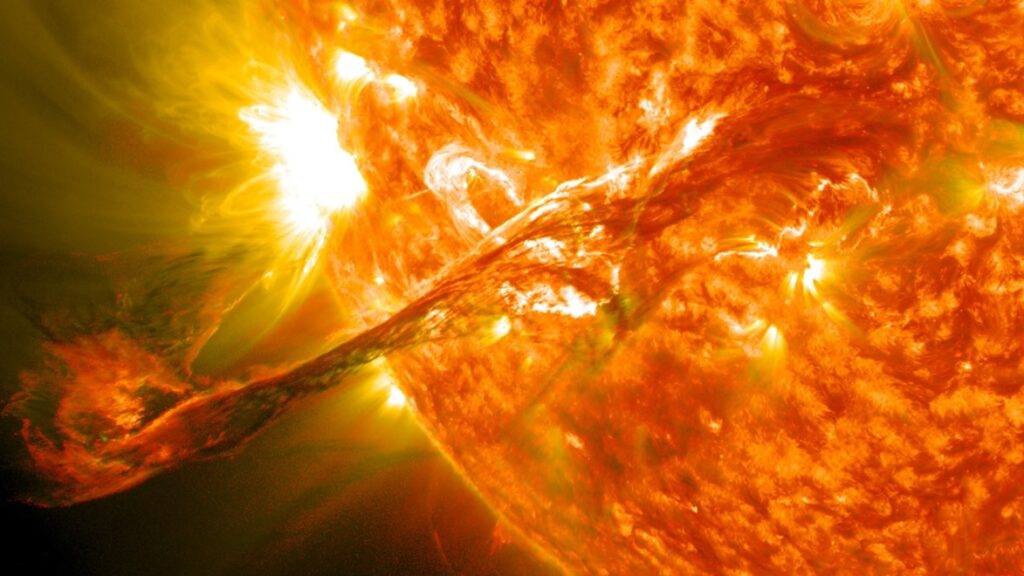
When solar activity contorts and realigns the sun’s magnetic fields, vast amounts of energy can be driven into space. This phenomenon can create a sudden flash of light—a solar flare. This picture features a filament eruption on the sun, accompanied by solar flares. NASA/GSFC/SDO.
Solar Variations Profoundly Influence Life on Earth, Especially Given the Degree to Which Humanity Depends on Technological Systems.
NASA’s Solar Dynamics Observatory (SDO) was built as with the intention of understanding the Sun’s magnetic changes, and how its energy is released into the heliosphere.
“The sun sends out a constant flow of charged particles called the solar wind, which ultimately travels past all the planets to some three times the distance to Pluto before being impeded by the interstellar medium. This forms a giant bubble around the sun and its planets, known as the heliosphere” (NASA).

Artist’s concept of the Solar Dynamics Observatory Satellite, a space-based telescope that continually watches the sun in different wavelengths. NASA/Goddard Space Flight Center/Conceptual Image Lab.
Launched in 2010, the SDO’s main goal is to understand “how the Sun creates solar activity and drives space weather – the dynamic conditions in space that impact the entire solar system, including Earth. SDO’s measurements of the Sun – from the interior to the atmosphere, magnetic field, and energy output – have greatly contributed to our understanding of our closest star.” (NASA’s SDO Website).
In February 2023, the Space Weather Prediction Center (SWPC), of the National Oceanic and Atmospheric Administration (NOAA), reported the emergence and fast growth of a magnetically-complex sunspot group named the Active Region (AR) 3213. This region produced a double-peaked solar flare capable of causing high-frequency communication blackouts – in this case, fortunately mainly over central Pacific waters.
“A solar flare is basically a giant explosion on the surface of our Sun which occurs when magnetic field lines from sunspots [darker, cooler and magnetically stronger parts of the Sun’s surface] tangle and erupt. A solar flare is defined as a sudden, rapid, and intense variation in brightness. [It] occurs when magnetic energy that has built up in the solar atmosphere is suddenly released. Material is heated to many millions of degrees in just minutes and radiation, and emitted across virtually the entire electromagnetic spectrum” (Space Weather).
This was what astronomers refer as an M flare. Strong M-class flares can cast charged particles at Earth, amplifying our planet’s auroras, also known as northern lights and southern lights.

Though it was Italian astronomer Galileo Galilei who coined the name “aurora borealis” in 1619 — after the Roman goddess of dawn, Aurora, and the Greek god of the north wind, Boreas — the earliest suspected record of the northern lights is in a 30,000-year-old cave painting in France. (Space.com). Image: Visit Greenland.
Solar flares are classified as A, B, C, M or X according to the energy released at peak flux (measured in watts per square meter).
M-class solar flares are considered medium-large flares and can cause solar radiation storms and minor to moderate radio blackouts on the sunlit side of Earth. The strongest flares might even launch gigantic clouds of solar plasma into space, known as coronal mass ejections, which can cause geomagnetic storms and damage technologies such as satellites and power lines, as well as generate intense auroral displays.
“Coronal Mass Ejections (CMEs) are large expulsions of plasma and magnetic field from the Sun’s corona. They can eject billions of tons of coronal material and carry an embedded magnetic field (frozen in flux) that is stronger than the background solar wind interplanetary magnetic field (IMF) strength” (SWPC/NOAA).
Solar flares can release energy equivalent to millions of nuclear bombs, all at once. X-class flares, the strongest of them all, occur about 10 times a year and can result in severe or extreme geomagnetic storming that threaten essential systems on Earth.
A sufficiently powerful solar flare leading to coronal mass ejections could disable the electrical grid and induce short circuits in anything that uses electrical circuits. It has been estimated that a powerful magnetic flare hitting the Earth, like the Carrington Event of 1859 and similarly powerful solar storms recorded in 1921, 1960, 1989, and 2012, could result in $2 trillion or more of economic damage. The storm of March, 1989 caused a 12-hour electrical blackout in the Canadian province of Quebec, plunging more than 6 million people into darkness.

The Sun’s corona is the outermost part of the Sun’s atmosphere. The corona is usually hidden by the bright light of the Sun’s surface. That makes it difficult to see without using special instruments. However, the corona can be viewed during a total solar eclipse (NASA). Image: Andrea Stöckel.
In January 2023, NASA reported massive X-class solar storms from sunspot AR 3184, causing a temporary, but strong, radio blackout across parts of South America, Central America and the Pacific Ocean. As they explain, these explosions “can impact radio communications, electric power grids, navigation signals, and pose risks to spacecraft and astronauts.”
Given the possible repercussions of these events, with widespread disruption to our everyday lives, scientists have long been trying to refine our ability to predict and prepare for them. However, one major problem is our limited knowledge about what’s happening on the side of the Sun that faces away from Earth. So, the best option for astronomers is to monitor visible sunspots and roughly calculate the probability of a solar flare or a CME. They can’t know the exact time and strength of an impending outburst, however, and have only a limited ability to predict its potential impact on Earth.

Artist’s impression of the Solar and Heliospheric Observatory (SOHO), a joint mission by NASA and the European Space Agency that was launched in 1995 and, like the SDO, also regularly watches for space weather events. Source: European Space Agency.
“The solar flare is electromagnetic radiation, that is essentially light, including visible and all other wavelengths including gamma rays and radio frequencies”, explains ESA’s Head of Space Weather Office Juha Pekka Luntama. “The moment we see it, it’s already affecting Earth’s ionosphere and causing disruption. (…) If you have a GPS or GNSS receiver, then you will see a navigation error because the characteristics of the upper atmosphere change.”
During the Halloween Storms of 2003, the strongest solar storm ever recorded, satellite systems and communications were affected and aircraft needed to be re-routed, said Dr. Holly Gilbert from NASA’s Goddard Space Flight Center. “Solar and Heliospheric Observatory (SOHO) satellite, a collaboration between NASA and the European Space Agency (ESA), failed temporarily (…). These storms were so powerful [that] they created aurora that could be seen as far south as Florida.”
The greatest consequences come from coronal mass ejections, which occur when solar flares are sufficiently powerful.
“The effects of the solar flare last a few hours in the worst case. The conditions return to normal, and then the CME arrives, and the geomagnetic storm starts. So, there is the first impact, then there is a bit of a gap. And then there is another impact. And they all come from the same solar event,” said Luntama.
In a 2023 paper published in The Astrophysical Journal, Dr. KD Leka of NorthWest Research Associates, and co-authors studied the upper layers of the solar atmosphere, called the corona, and found new clues that could help predict which regions on the Sun are more likely to produce solar flares. More specifically, they found that the corona frequently produced small-scale flashes in the regions about to flare.
“Our results may give us a new marker to distinguish which active regions are likely to flare soon and which will stay quiet over an upcoming period of time,” said Dr. Leka.
Their work was only possible because of a newly created database, released in another 2023 paper and published in the same journal. Led by Dr. Karin Dissauer and co-authored by other scientists, including Dr. Leka, the study combined over eight years of images taken by the SDO of active regions in ultraviolet and extreme-ultraviolet light, making it publicly available.
“Down the road, combining all this information from the surface up through the corona should allow forecasters to make better predictions about when and where solar flares will happen,” said Dr. Dissauer.
Scientific research has changed our lives in many ways over the course of history, and GPS technology is one example of how today’s everyday living depends on the satellites we have placed in Earth’s orbit.
Given our increasing reliance on this type of technology, for instance for self-driving cars, the consequences of extremely strong explosions on the Sun’s surface are increasingly relevant. However, as our scientific understanding of solar flares and coronal mass ejections evolves, we are becoming more prepared for these events. But will we know soon enough to prevent major damage and disruption?



